博文
PhD Thesis: Chapter VI Interface Involving Derivation
|||
This chapter studies some challenging problems of Chinese derivation and its interface with syntax. These problems have been a challenge to existing word segmenters; they are also long-standing problems for Chinese grammar research.
It is observed that a good number of signs have become more and more like affixes as the Chinese language develops. Typical, indisputable examples include signs like the nominalizer 性 ‑xing (-ness) and the prefix 第 di- (-th). While few people doubt the existence of affixes in Contemporary Chinese, there is no general agreement on the exact number of Chinese affixes, due to a considerable number of borderline cases often referred to as ‘quasi-affixes’ (类语缀 lei yu-zhui).[1] It will be argued that the quasi-affixes belong to morphology and are structurally not different from other affixes. The major difference between ‘quasi-affixes’ and the few generally honored (‘genuine’) affixes lies mainly in the following aspect. The former retain some ‘solid’ meaning while the latter are more functionalized. However, this does not prevent CPSG95 from providing a proper treatment of quasi-affixes in the same way as it handles other affixes. It will be shown that the difference in semantics between affixes or quasi-affixes can be accommodated fairly easily in the CPSG95 lexicon.
Based on the examination of the common property of Chinese affixes and quasi-affixes, a general approach to Chinese derivation is proposed. This approach not only enables us to handle quasi-affix phenomena, but is also flexible enough to provide an adequate treatment of a special problem in Chinese derivation, namely zhe-suffixation. The affix status of 者 -zhe (-er) is generally acknowledged (classified as suffix in the authoritative books like Lü et al 1980): it attaches to a verb sign and produces a word. The peculiar aspect of this suffix is that the verb stem which it attaches to can be syntactically expanded. In fact, there is significant amount of evidence for the argument that this suffix expects a VP as its stem (see 6.5 for evidence). Since a VP is only formed in syntax and derivation is within the domain of morphology, this phenomenon presents a highly challenging case on how morphology should be interfaced properly to syntax. The solution which is offered in CPSG95 demonstrates the power of designing morphology and syntax in an integrated grammar formalism. In contrast, in any system which enforces sequential processing of derivation morphology before syntax - most traditional systems assume this, this is an unsolvable problem. There does not seem to be a way of enabling partial output of syntactic analysis (i.e. VP) to feed back to some derivation rule in the preprocessing stage.
In Section 6.1, the general approach to Chinese derivation is proposed first. Following this proposal, prefixation is illustrated in 6.2 and suffixation in 6.3. Section 6.4 shows that this general approach to derivation applies equally well to the 'quasi-affix' phenomena. Section 6.5 investigates the suffixation of -zhe (-er). The analysis is based on the argument that this suffixation involves the combination VP+-zhe. The specific solution following the CPSG95 general approach will be presented based on this analysis.
6.1. General Approach to DerivationThis section examines the property of Chinese affixes and proposes a corresponding general approach to Chinese derivation. This serves as the basis for the specific solutions to be presented in the remaining sections to various problems in Chinese derivation.
It is fairly easy to observe that in Chinese derivation it is the affix which selects the stem, not the other way round. For example, the suffix 性 -xing (‑ness) expects an adjective to produce an (abstract) noun. Based on the examination of the behavior of a variety of Chinese affixes or quasi-affixes, the following generalization has been reached. That is, an affix lexically expects a sign of category x, with possible additional constraints, to form a derived word of category y. This generalization is believed to capture the common property shared by Chinese affixes/quasi-affixes. It seems to account for all Chinese derivational data, including typical affixation, quasi-affixation (see 6.4) and the special case of zhe-suffixation (see 6.5). So far no counter evidence has been found to challenge this generalization.
The observation and the generalization above support the argument that in a grammar which relies on lexicalized expectation feature structures to drive the building of structures, affixes, not the stems, should be selecting heads of the morphological structures.[2] Leaving aside the non-productive affixation,[3] the general strategy to Chinese productive derivation is proposed as follows. In the lexicon, the affix as head of derivative is encoded with the following derivation information: (i) what type of stem (constraints) it expects; (ii) where to look for the expected stem, on its right or left; (iii) what type of (derived) word it leads to (category, semantics, etc.). Based on this lexical information, CPSG95 has two PS rules in the general grammar for derivation: one for prefixation, one for suffixation.[4] These rules ensure that all the constraints be observed before an affix and a stem are combined. They also determine that the output of derivation, i.e. the mother sign, be a word.
Along this line, the key to a lexicalized treatment of Chinese derivation is to determine the structural and semantic property of the derivative and to impose proper constraints on the expected stem. The constraints on the expected stem can be lexically specified in the morphological expectation feature [PREFIXING] or [SUFFIXING] of the affix. The property (category, syntactic expectation, semantics, etc.) of the derivative can also be encoded directly in the lexical entry of the affix, seen as the head of a derivational structure in the CPSG95 analysis. This property information, as part of head features, will be percolated up when the derivation rules are applied.
In the remaining part of this chapter, it will be demonstrated how this proposed general approach is applied to each specific derivation problem.
6.2. PrefixationThe purpose of this section is to present the CPSG95 solution to Chinese prefixation. This is done by formulating a sample lexical entry for the ordinal prefix 第 di- (-th) in CPSG95. It will be shown how the lexical information drives the prefix rule in the general grammar for the derivational combination.
Thanks to the productivity of the prefix 第 di- (-th), the ordinal numeral is always a derived word from the cardinal numeral via the following rule, informally formulated in (6-1).
(6-1.) 第 di- + cardinal numeral --> ordinal numeral
第22条军规
di- 22 tiao jun-gui
-th 22 CLA military-rule
the 22-nd military rule (Catch-22)
第八个是铜像
di- ba ge shi tong-xiang
-th eight CLA be bronze-statue
The eighth is the bronze statue.
The basic function of the Chinese numeral, whether cardinal or ordinal, is to combine with a classifier, as shown in the sample sentences above.
To capture this phenomenon, CPSG95 defines two subtypes for the category numeral [num], namely the [cardinal_num] and [ordinal_num]. The lexical entries of the prefix 第 di‑ (‑th) and the cardinal numeral 五 wu (five) are formulated in (6-2) and (6-3). The prefix encodes the lexical expectation for the derivation 第 di- + [cardinal_num] ‑‑> [ordinal_num] plus the semantic composition of the combination. Note that the constraint @numeral inherits all common property specified for the numeral macro.
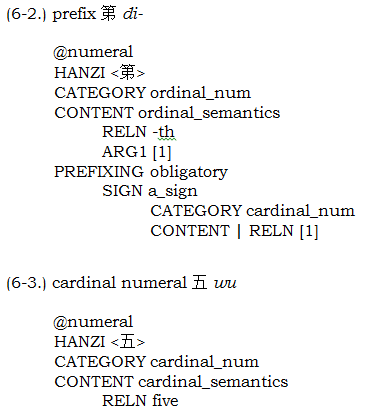
As indicated before, prefixation in CPSG95 is handled by the Prefix PS Rule based on the lexical specification. More specifically, it is driven by the lexical expectation encoded in [PREFIXING]. The prefix rule is formulated in (6-4).
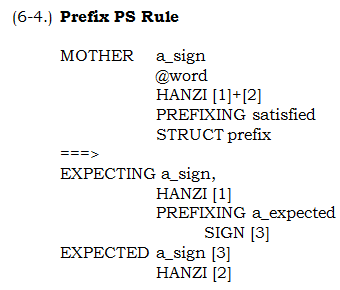
Like all PS rules in CPSG95, whenever two adjacent signs satisfy all the constraints, this rule takes effect in combining them into a higher level sign in parsing. For example, the prefix 第 di- (-th) and the sign 五 wu (five) will be combined into the sign as shown in (6-5).

The combination of 第五 di+wu in (6-5) demonstrates how the morphological structure is built in the CPSG95 approach to Chinese prefixation.
6.3. SuffixationLike prefixation, the Suffix PS Rule for suffixation is driven by the lexically encoded expectation in [SUFFIXING]. Parallel to the Prefix PS Rule, the suffix rule is formulated in (6-6).
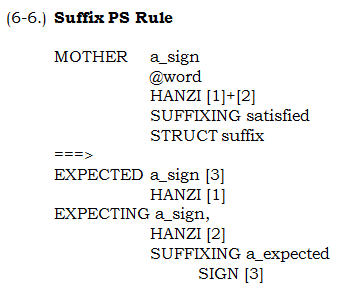
With this PS rule in hand, all that is needed is to capture the individual derivational constraint in the lexical entries of the suffixes at issue. For example, the suffix 性 -xing (-ness) changes an adjective or verb into an abstract noun: A/V + ‑xing ‑‑> N. This information is contained in the formulation of the suffix 性 –xing (-ness) in the CPSG95 lexicon, as shown in (6-7).
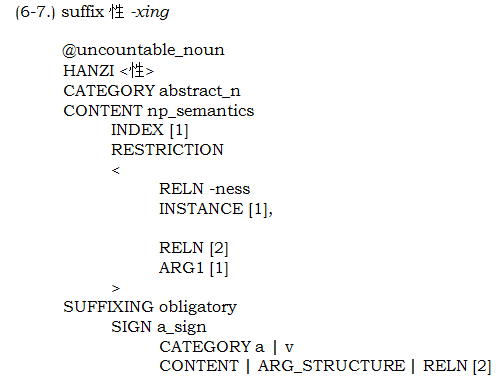
Note that abstract nouns are uncountable, hence the call to the uncountable_noun macro to inherit the common property of uncountable nouns.[5]
Suppose the suffix 性 -xing (-ness) appears immediately after the adjective 实用 shi-yong (practical) formulated in (6-8), the suffix PS rule will combine them into a noun, as shown in (6-9).
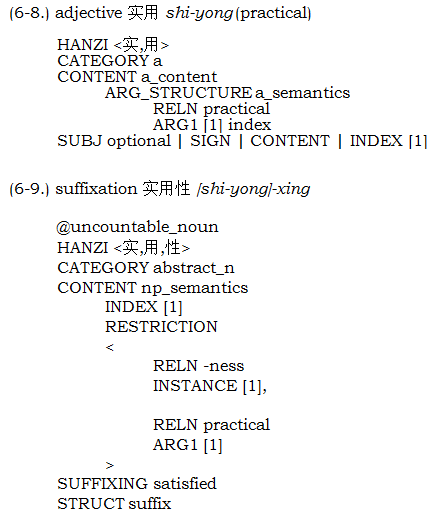
The combination of 实用性 shi-yong+xing in (6-9) demonstrates how the morphological structure is built in the CPSG95 approach to Chinese suffixation.
6.4. Quasi-affixesThe purpose of this section is to propose an adequate treatment of the quasi-affix phenomena in Chinese. This is an area which has not received enough investigation in the field of Chinese NLP. Few Chinese NLP systems demonstrate where and how to handle these quasi-affixes.
To achieve the purpose, typical examples of ‘quasi-affixes’ are presented and compared with some ‘genuine’ affixes. The comparison highlights the general property shared by both 'quasi-affixes' and other affixes and also shows their differences. Based on this study, it is found to be a feasible proposal to treat quasi-affixes within the derivation morphology of CPSG95. The proposed solution will be presented by demonstrating how a typical quasi-affix is represented in CPSG95 and how the general affix rules can work with the lexical entries of 'quasi-affixes' as well.
The tables in (6-10) and (6-11) list some representative quasi-affixes in Chinese.
(6-10.) Table for sample quasi-prefixes
| prefixation | examples |
| lei (quasi-)+N --> N | 类前缀 lei-[qian-zhui]: quasi-[pre-fix] 前缀 qian (before, pre-, former-) zhui (...) |
| ban (semi-)+N --> N | 半文盲 ban-[wen-mang]: semi-illiterate 文盲 wen (written-language), mang (blind) |
| dan (mono-)+N --> N | 单音节 dan-[yin-jie]: mono-syllable 音节 yin (sound), jie (segment) |
| shuang (bi-)+N --> N | 双音节 shuang-[yin-jie]: bi-syllable |
| duo (multi-)+N --> N | 多音节 duo-[yin-jie]: multi-syllable |
| fei (non-)+N/A --> A | 非谓 fei-wei: non-predicate 非正式 fei-[zheng-shi]: non-official |
| xiang (each other)+Vt (mono-syllabic) --> Vi | 相爱 xiang-ai: love each other |
| zi (self-)+Vt --> Vi | 自爱 zi-ai: self-love zi-xue-xi: self-learning |
| qian (former, ex-) + N --> N | 前夫人 qian-[fu-ren]: ex-wife 前总统 qian-[zong-tong]: former president |
(6-11.) Table for sample quasi-suffixes
| suffixation | Examples |
| N + shi (style) --> N | 美国式 [mei-guo]-shi: American-style |
| NUM/N + xing (model) --> N | 1980型 1980-xing: 1980 model; IV型 IV-xing: Model IV |
| A/V + lü (rate) --> N | 准确率 [zhun-que]-lü: (percentage of) precision |
| NUM + liu (class) --> A | 一流 yi-liu: first class 三流 san-liu: third class |
| N + mang ('blind', person who has little knowledge of) --> N | 法盲 fa-mang: person who has no knowledge of law 计算机盲 [ji-suan-ji]-mang: computer-layman |
Compare the above quasi-affixes with the few widely acknowledged affixes like 性 -xing (-ness) and 第 di- (-th), it is fairly easy to observe that the property as generalized in Section 6.1 is shared by both affixes and quasi-affixes. That is, in all cases of the combination, the affix or quasi-affix expects a sign of category x, with possible additional constraints, either on the right or on the left to form a derived word of category y (y may be equal to x). For example, the quasi-prefix 自 zi- (self-) expects a transitive verb to produce an intransitive verb, etc. This property supports the following two points of view: (i) the affix or quasi-affix is the selecting head of the combination; (ii) both types of combination (affixation) should be properly contained in morphology since the output is always a word (derivative).
In terms of difference, it is observed that there are different degrees of the functionalization of the meaning between quasi-affixes and other affixes. For example, the nominalizer 性 -xing (‑ness) seems to be semantically more functionalized than the quasi-suffix 盲 -mang (blind-man, person who has little knowledge of). In the case of 性 -xing (-ness), there is believed to be little semantic contribution from the affix. But in cases of affixation by quasi-affixes, the semantic contribution of the affixes is non-trivial, and it must be ensured that proper semantics be built based on semantic compositionality of both the stem and the affix.
Except for the different degrees of semantic abstractness, there is no essential grammatical difference observed between quasi-affixes and the few widely accepted affixes. As the semantic variation can be easily accommodated in the lexicon, nothing needs to be changed in the general approach to Chinese derivation as described before. The text below demonstrates how the quasi-affix phenomena are handled in CPSG95, using a sample quasi-affix to show the derivation.
The quasi-prefix to examine is 相 xiang- (each other). It is used before a mono-syllabic transitive verb, making it an intransitive verb: 相 xiang- + Vt (monosyllabic) ‑‑> Vi. More precisely, the syntactic object of the transitive verb is morphologically satisfied so that the derivative becomes an intransitive verb.
Unlike the original verb, the verb derived via xiang-prefixation requires a plural subject, as shown in (6-12). This is a linguistically interesting phenomenon. In a sense, it is a version of subject-predicate agreement in Chinese.
(6-12.) (a) 他们相爱过。
ta-men xiang- ai guo
they each-other love GUO
They used to love each other.
(b) 他爱过。
ta ai guo
he love GUO.
He used to love (someone).
(b) * 他相爱过。
ta xiang- ai guo
he each-other love GUO.
This number agreement can help decode the plural semantics of the subject noun as shown in the first sentence (6-13a) in the following group. Sentence (6-13a) illustrates a common, number-underspecified case where the NP has no plural marker. This contrasts with (6-13b) which includes a plural marker 们 men (-s), and with (6-13c) which resorts to the use of a numeral-classifier construction.
(6-13.) (a) 孩子相爱了。
hai-zi xiang- ai le
child each-other love LE
The children have fallen in love with each other.
(b) 孩子们相爱了。
hai-zi men xiang- ai le
child PLU each-other love LE
The children have fallen in love with each other.
(c) 两个孩子相爱了。
liang ge hai-zi xiang- ai le
two CLA child each-other love LE
The two children have fallen in love with each other.
Following the practice for number agreement in HPSG, the agreement can be captured by enforcing an additional plural constraint on the subject expectation [SUBJ | SIGN | CONTENT | INDEX | NUMBER plural], as shown in the formulation of the lexical entry for 相 xiang- (each other) in (6-14) below.

As shown above, the affixation also necessitates corresponding modification of the semantics in the argument structure: the first argument is equal to the second via index [2].[6] Note that the notation [ ], or more accurately, the most general feature structure, is used as a place holder. For example, HANZI <[ ]> stands for the constraint of a mono-hanzi sign. Another thing worth noticing is that the derivative requires that a subject must appear before it. In other words, the subject expectation becomes obligatory. This is based on the fact that this derived verb cannot stand by itself in syntax, unlike most original verbs in Chinese, say 爱 ai (love), whose subject expectation is optional.
With the lexical entries for the quasi-affixes taking care of the differences in the building of semantics, there is no need for any modification of the CPSG95 PS rules. For example, the prefix 相 xiang- (each other) and the verb 爱 ai (love) formulated in (6-15) will be combined into the derivative 相爱 xiang-ai (love each other) shown in (6-16) via the Prefix PS Rule.

In summary, the proposed approach to Chinese derivation is effective in handling quasi-affixes as well. The general grammar rules for derivation remain unchanged while lexical constraints are accommodated in the lexicon. This demonstrates the advantages of the lexicalized design for grammar development.
6.5. Suffix 者 zhe (-er)This section analyzes zhe-suffixation, a highly challenging case at the interface between morphology and syntax. This is believed to be an unsolvable problem as long as a system is based on the sequential processing of derivation morphology and syntax. The solution to be proposed in this section is based on the argument that this suffixation is a combination of VP+zhe.
The suffix 者 zhe (-er, person) is a very productive bound morpheme. It is often compared to the English suffix ‑er or ‑or, as seen in the pairs in (6-17).
(6-17.)
工作 gong-zuo (work) 工作者 [gong-zuo]-zhe (work‑er)
劳动 lao-dong (labor) 劳动者 [lao-dong]-zhe (labor-er)
学习 xue-xi (learn) 学习者 [xue-xi]-zhe (learn-er);.
But 者 ‑zhe is not an ordinary suffix; it belongs to the category of so-called ‘phrasal affix’,[7] with very different characteristics than the English counterpart. Although the output of the zhe-suffixation is a word, the input is a VP, not a lexical V. In other words, it combines with a VP and produces a lexical N: VP+zhe --> N. The arguments to be presented below support this analysis.
The first thing is to demonstrate the word status of zhe‑suffixation. This is fairly straightforward: there are no observed facts to show that the zhe-derivative is different from other lexical nouns in the syntactic distribution. For example, like other lexical nouns, the derivative can combine with an optional classifier construction to form a noun phrase. Compare the following pairs of examples in (6-18) and (6-19).
(6-18.) (a) 两名违反这项规定者
liang ming [[wei-fan zhe xiang gui-ding] -zhe]
two CLA violate this CLA regulation -er
two persons who have violated this regulation
(b) 两名学生
liang ming xue-sheng
two CLA student
two students
(6-19.) (a) 他是一位优秀工作者
ta shi yi wei you-xiu [[gong-zuo] -zhe]
he be one CLA excellent work -er
He is an excellent worker.
(b) 他是一位优秀工人。
ta shi yi wei you-xiu gong-ren
he be one CLA excellent worker
He is an excellent worker.
The next thing is to demonstrate the phrasal nature of the ‘stem’.[8] The stem is judged as a VP because it can be freely expanded by syntactical complements or modifiers without changing the morphological relationship between the stem and the suffix, as shown in (6‑20) below. (6-20a) involves a modifier (努力 nu-li) before the head verb. The verb stem in (6-20b) and (6-20c) is a transitive VP consisting of a verb and an NP object.
(6-20.) (a) 努力工作者
[nu-li gong-zuo] -zhe
hard work ‑er
hard-worker, person who works hard
(b) 学习鲁迅者
[xue-xi Lu Xun] -zhe
learn Lu Xun -er
person who is learning from Lu Xun
(c) 违反这项规定者
[wei-fan zhe xiang gui-ding] -zhe
violate this CLA regulation -er
person who violates this rule
More examples with the head verb 雇 gu (employ) are given in (6-21), with the last two expressions involving passivized VP.
(6-21.)(a) 雇者
gu-zhe
employ-er
(b) 雇人者
[gu ren] -zhe
employ person -er
those who employ people, employer/recruiter
(c) 被雇者
[bei gu] -zhe
[be-employed] -er
employee
(d) 被人雇者
[bei ren gu] -zhe
by person employ -er
those who are employed by (other) people
In fact, the stem VP is semantically equivalent to a relative clause. A Chinese relative clause is normally expressed in the form of a DE-phrase: VP+de+N (Xue 1991). In other words, 者 ‑zhe embodies functions of two signs, an N (‘person’, by default) and a relative clause introducer de, something like English one that + VP (or person who + VP).[9] Compare the two examples in (6-22) and (6-23) with the same meaning - the expression in (6-23) is more colloquial than the first in (6-22) which uses the suffix 者‑zhe.
(6-22.) 违反规定者,处以罚款。
wei-fan gui-ding zhe, chu-yi fa-kuan
violate regulation one that punish-by fine
Those who violate the regulations will be punished by fines.
(6-23.) 违反规定的人,处以罚款。
wei-fan gui-ding de ren, chu-yi fa-kuan
violate regulation DE person punish-by fine
Those who violate the regulations will be punished by fines.
On further examination, it is found that VPs with attached aspect markers combine with the suffix 者 -zhe with difficulty, as seen in the following examples.
(6-24.) (a) 违反规定者
wei-fan gui-ding zhe
violate regulation -er
Those who violate the regulations
(b) ? 违反了规定者
wei-fan le gui-ding zhe
violate LE regulation one that
This means that some further constraint may be necessary in order to prevent the grammar from producing strings like (6-24b). If CPSG95 is only used for parsing, such a constraint is not absolutely necessary because, in normal Chinese text, such input is almost never seen. Since CPSG95 is intended to be procedure-neutral, for use in both parsing and generation, the further constraint is desirable.
This constraint is in fact not an isolated phenomenon in Chinese grammar. In syntax, the constraint is commonly required when the VP is not in the predicate position.[10] For example, when a verb, say 喜欢 xi-huan (like), or a preposition, say 为了 wei-le (in order to), subcategorizes for a VP as a complement, it actually expects a VP with no aspect markers attached. The following pair of sentences demonstrates this point.
(6-25.) (a) 我喜欢打篮球。
wo xi-huan da lan-qiu.
I like play basket-ball
I like playing basket-ball.
(b) * 我喜欢打了篮球。
wo xi-huan da le lan-qiu
I like play LE basket-ball
To accommodate such common constraint requirement in both Chinese morphology and syntax, a binary feature [FINITE] is designed for Chinese verbs in CPSG95. In the lexicon, this feature is under-specified for each Chinese verb, i.e. [FINITE bin]. When an aspect marker 了着过 le/zhe/guo combines with the verb, this feature is unified to be [FINITE plus]. We can then enforce the required constraint [FINITE minus] in the morphological expectation or syntactic expectation to prevent aspected VP from appearing in a position expecting a non-predicate un-aspected VP.
Based on the above analysis, the lexical entry of the suffix 者 –zhe is formulated in (6-26). Note the notation for the macro with parameter (placed in parentheses) @common_noun(名|位|个). This macro represents the following information. The derivative is like any other common noun, it inherits the common property; it can combine with an optional classifier construction using the classifier 名 ming or 位 wei or 个 ge.[11]
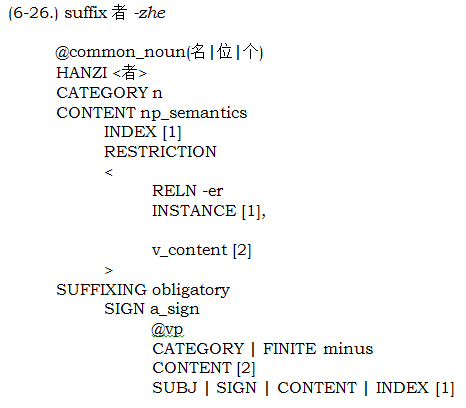
As seen, the VP expectation is realized by using the macro constraint @vp. The semantics of the derivative is [np_semantics], an instance of -er with restriction from the event of VP, represented by [2]. The index [1] ensures that whatever is expected as a subject by the VP, which has no chances to be satisfied syntactically in this case, is semantically identical to this noun.[12] In other words, this derived noun semantically fills an argument slot held by the subject in the VP semantics [v_content]. In the active case, say, 雇人者 [gu ren]–zhe (‘person who employs people’), the subject is the first argument, i.e. the index of this noun is the logical subject of employ. However, when the VP is in passive, say, 被人雇者 [bei ren gu]‑zhe (‘person who is employed by other people’), the subject expected by the VP fills the second argument, i.e. the noun in this case is the logical object of the VP. It is believed that this is the desired result for the semantic composition of zhe-derivation.
With the lexical expectation of the suffix as the basis, the general Suffix PS Rule is ready to work. Remember that there is nothing restricting the input stem to the derivation in either of the derivation rules, formulated in (6-4) and (6-6) before. In CPSG95, this is not considered part of the general grammar but rather a lexical property of the head affix. It is up to the affix to decide what constraints such as category, wordhood status, semantic constraint, etc., to impose on the expected stem to produce a derivative. In most cases of derivation, the input status of the stem is a word, but now we have an intricate case where the suffix zhe (-er) expects a verb phrase for derivation. The general property for all cases of derivation is that regardless of the input, the output of derivation (as well as any other types of morphology) is always a word.
Before demonstrating by examples how zhe-derivation is implemented, there is a need to address the configurational constraints of CPSG95. This is an important factor in realizing the flexible interaction between morphology and syntax as required in this case.
In all HPSG-style grammars, some type of configurational constraint is in place to ensure the proper order of rule application. A typical constraint is that the subject rule should apply after the object rule. This is implemented in CPSG95 by imposing the constraint in the subject PS rule that the head daughter must be a phrase and by imposing the constraint in the object PS rule that the subject of the head daughter may not be satisfied.[13]
Since derivation morphology and syntax are designed in the same framework in CPSG95, constraints are called for to ensure the ordering of rule application between morphological PS rules and syntactic PS rules as well. In general, morphological rules apply before syntactic rules. However, if this constraint is made absolute, to the extent that that all morphological rules must apply before all syntactic rules, we in effect make morphology and syntax two independent, successive modules, just like the case for traditional systems. The grammar will then lose the power of flexible interaction between morphology and syntax and cannot handle cases like zhe-derivation. However, this is not a problem in CPSG95.
The proposed constraint regulating the rule application order between morphological PS rules and syntactic PS rules is as follows. Only when a sign has both obligatory morphological expectation and syntactic expectation will CPSG95 have constraints ensuring that the morphological rule apply first. For example, as formulated in (6-14) before, the sign 相 xiang- (each other) has both morphological expectation in [PREFIXING] as a bound morpheme and syntactic expectation for the subject in [SUBJ] as (head of) derivative. If the input string is 他们相爱 ta-men (they) xiang- (each other) ai (love), the prefix rule will first combine 相 xiang- (each other) and the stem 爱 ai (love) before the subject rule can apply. The result is the expected structure embodying the results of both morphological analysis and syntactic analysis, [ta-men [xiang- ai]]. This constraint is implemented by specifying in all syntactic PS rules that the head daughter cannot have obligatory morphological expectation yet to be satisfied. It effectively prevents a bound morpheme from being used as a constituent in syntax. It should be emphasized that this constraint in the general grammar does not prohibit a bound morpheme from combining with any types of sign; such constraints are only lexically decided in the expectation feature of the affix.
The following text shows step by step the CPSG95 solution to the problem of zhe-derivation. The chosen example is the derivation for the derived noun 违法规定者 [[wei-fan gui-ding]-zhe] ‘persons violating (the) regulation’. The lexical sign of the suffix 者 -zhe (-er) has already been formulated in (6-26) before. The words 违反 wei-fan (violate) and 规定 gui-ding (regulation) in the CPSG95 lexicon are shown in (6-27) and (6-28) respectively.
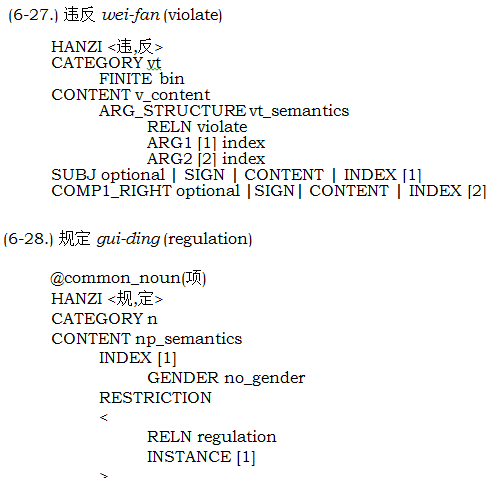
Note that all common nouns, specified as @common_noun, in the lexicon have the following INDEX features [PERSON 3, NUMBER number], i.e. third person with unspecified number. As for the feature [GENDER], it is encoded in the noun itself with one of the following [male], [female], [have_gender], [no_gender] or unspecified as [gender]. The corresponding sort hierarchy is: [gender] consists of sub-sorts [no_gender] and [have_gender]; and [have_gender] is sub-typed into [male] and [female]. Of course, 规定 gui-ding (regulation) is lexically specified as [GENDER no_gender].
The following is the VP built by the object PS rule in the CPSG95 syntax. As seen, the building of the semantics follows the practice in HPSG, with the argument slots filled by the [INDEX] feature of the subject and object. In this VP case, [ARG2] has been realized.
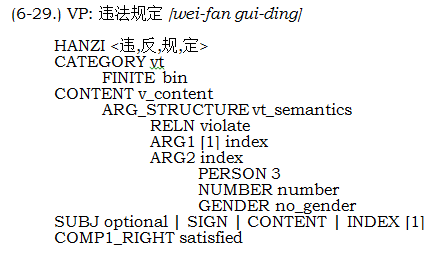
The VP result in (6-29) and the suffix 者 –zhe will combine into the expected derived noun via the Suffix PS Rule, as shown in (6-30).
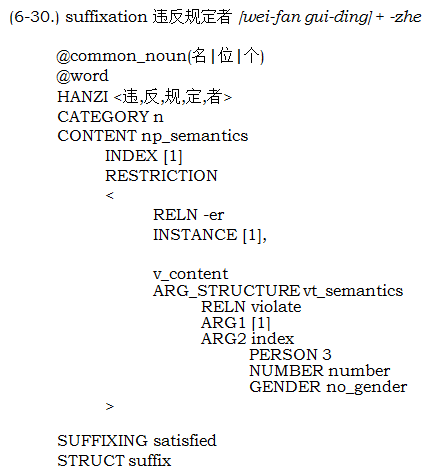
To summarize, it is the integrated model of derivational morphology and syntax in CPSG95 that makes the above analysis implementable. Without the integration, there is no way that a suffix is allowed to expect a phrasal stem.[14] The lexicalist approach adopted in CPSG95 facilitates the capturing of the individual feature of the phrase expectation for the few individual affixes like 者 -zhe. This enables the general PS rules for derivation in CPSG95 to be applicable to both typical cases of affixation and special cases of affixation.
6.6. SummaryThis chapter has investigated some representative phenomena of Chinese derivation and their interface to syntax. The solutions to these problems have been presented based on the arguments for the analysis.
The key to a lexicalized treatment of Chinese derivation is to determine the structural and semantic property of the derivative and to impose proper constraints on the expected stem. The constraints on the expected stem are lexically specified in the corresponding morphological expectation feature structure of the affix. The property of the derivative is also lexically encoded in the affix, seen as head of derivational structure in the CPSG95 analysis. This property information will be percolated up when the derivation rules are applied. These rules ensure that the output of derivation is a word. It has been shown that this approach applies equally well to derivation via ‘quasi-affixes’ and the tough case of zhe-suffixation as well.
------------------------------------
[1] Some linguists (e.g. Li and Thompson 1981) hold the view that Chinese has only a few affixes; others (e.g. Chao 1968) believe that the inventory of Chinese affixes should be extended to include quasi-affixes. Interestingly, the sign lei (quasi-, original sense ‘class’) itself is a quasi-prefix in Chinese. Phenomena similar to Chinese quasi-affixes, called ‘semi-affixes’ or ‘Affixoide’, also exist in German morphology (Riehemann 1998).
[2] This is similar to the practice in many grammars, including HPSG, that a functional sign preposition is the selecting head of the corresponding syntactic structure, namely Prepositional Phrase.
[3] Those affixes which are not or no longer productive, e.g. lao‑ (original meaning ‘old’) in lao‑hu (tiger) and lao‑shu (mouse), are not a problem. The corresponding derived words are simply listed in the CPSG95 lexicon.
[4] The CPSG95 phrase-structural approach to Chinese productive derivation was inspired by the implementation in HPSG of a word-syntactic approach in Krieger (1994). Similar practice is also seen in Selkirk (1982), Riehemann (1993) and Kathol (1999) in an effort to explore alternative approaches than the lexical rule approach to morphology.
[5] The major common property is reflected in two aspects, formulated in the macro definition of uncountable_noun in CPSG95. First, there is value setting for the [NUMBER] feature, i.e. [CONTENT|INDEX|NUMBER no_number]. The CPSG95 sort hierarchy for the type [number] is defined as {a_number, no_number} where [a_number] is further sub-typed into {singular, plural}. [NUMBER no_number] applies to uncountable nouns while [NUMBER a_number] is used for countable noun where the plurality is yet to be decided (i.e. under-specified for plurality). Second, based on the syntactic difference between Chinese countable nouns and uncountable nouns, the classifier expected by uncountable nouns is exclusively zhong (kind/sort of). That is, uncountable nouns may only combine with a preceding classifier construction using the classifier zhong.
[6] For time being, the subtle difference in semantics between pairs like We love ourselves and We love each other is not represented in the content. It requires a more elaborate system of semantics to reflect the nuance. The elaboration of semantics is left for future research.
[7] Some linguists (e.g. Z. Lu 1957; Lü et al 1980; Lü 1989; Dai 1993) have briefly introduced the notion of ‘phrasal affix’ in Chinese. Lü further indicates that these ‘phrasal affixes’ are a distinctive characteristic of the Chinese grammar.
[8] The English possessive morpheme ‘s is arguably a suffix which expects an NP instead of a lexical noun as its stem: NP + -’s. Unlike VP + -zhe, the result of this NP + -‘s combination is generally regarded as a phrase, not a word. In this sense, ‘s seems to be closer to a functional word, similar to a preposition or postposition, than to a suffix.
[9] Chinese zhe-suffixation is somewhat like the English phenomenon of what-clause (in ‘what he likes is not what interests her’). ‘What’ in this use also embodies functions of two signs that which. But the English what-clause functions as an NP, but VP+zhe forms a lexical N.
[10] It is generally agreed in the circle of Chinese grammar research that Chinese predicate (or finite) verbs have aspect distinction, using or not using aspect markers. This is in contrast to English where both finite and non-finite verbs have aspect distinction but only finite verbs are tensed.
[11] It is generally agreed that each Chinese common noun may only combine with a classifier construction using a specific set of classifiers. This classifier specification is generally regarded as lexical, idiosyncratic information of nouns (Lü et al 1980). Using the macro with the classifier parameter follows this general idea. It is worth noticing that the lexical formulation for -zhe (-er) in CPSG95 does not rely on any specific NP analysis chosen in syntax, except that the classifier specification should be placed under the entry for nouns (or derived nouns).
[12] The proposal in building the semantics for the zhe-derivative is based on ideas similar to the assumption adopted for the complement control in HPSG that ‘the fundamental mechanism of control was coindexing between the unexpressed subject of an unsaturated complement and its controler’ (Pollard and Sag 1994:282).
[13] If the object expectation is obligatory, this constraint ensures the priority of the object rule over the subject rule in application, building the desirable structure [S [V O]] instead of [[S V] O]. This is because, a verb with obligatory object yet to be satisfied is by definition not a phrase. If the object expectation is optional, the order of rule application is still in effect although the lexical V in this scenario does not violate the phrase definition. There are two cases for this situation. In case one, the object O happens to occur in the input string. The subject PS rule will tentatively combine S and V via the subject rule, but it can go no further. This is because the object rule cannot apply after the subject rule, due to the constraint in the object rule that the head cannot have a satisfied subject. The successful parse will only build the expected structure [S [V O]]. In case two, the object O does not appear in the input string. Then the tentative combination [S V] built by the subject rule becomes the final parse.
[14] For example, if the lexical rule approach were adopted for derivation, this problem could not be solved.
[Related]
PhD Thesis: Morpho-syntactic Interface in CPSG (cover page)
PhD Thesis: Chapter I Introduction
PhD Thesis: Chapter II Role of Grammar
PhD Thesis: Chapter III Design of CPSG95
PhD Thesis: Chapter IV Defining the Chinese Word
PhD Thesis: Chapter V Chinese Separable Verbs
PhD Thesis: Chapter VI Morpho-syntactic Interface Involving Derivation
Overview of Natural Language Processing
Dr. Wei Li’s English Blog on NLP
https://blog.sciencenet.cn/blog-362400-999580.html
上一篇:PhD Thesis: Chapter V Chinese Separable Verbs
下一篇:【一日一parsing:谈parsing是问答系统的核武】